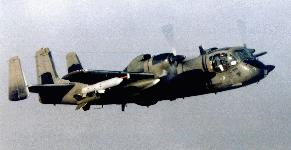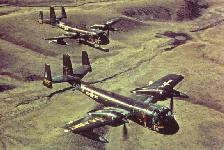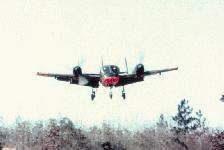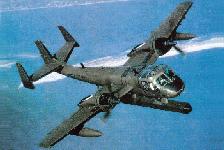




 The first Mohawk flew for the Army in 1960 as a visual observation aircraft. It was soon pressed into service in Vietnam. Its primary mission was gathering and relaying information on enemy activities. In subsequent years the mission and the aircraft underwent few changes. About 80 of the aircraft were built, and deployed in Vietnam, Germany, Desert Storm and Korea. Mohawk variants included the OV-1A, [visual and photographic], OV-1B [visual, photographic, and side-looking radar], the OV-1C [ visual, photographic, and infrared], and the OV-1D.
The first Mohawk flew for the Army in 1960 as a visual observation aircraft. It was soon pressed into service in Vietnam. Its primary mission was gathering and relaying information on enemy activities. In subsequent years the mission and the aircraft underwent few changes. About 80 of the aircraft were built, and deployed in Vietnam, Germany, Desert Storm and Korea. Mohawk variants included the OV-1A, [visual and photographic], OV-1B [visual, photographic, and side-looking radar], the OV-1C [ visual, photographic, and infrared], and the OV-1D.
 The OV-1 was designed for aerial reconnaissance. The bulging oversized glass canopy provided the crew with much more visibility than a standard, streamlined canopy, to facilitate the OV-l's initial mission in Vietnam, visual observation of enemy activities. The two place, twin turboprop aircraft's thick, straight wings were designed to provide maximum lift rather than speed, with a wing span longer than the fuselage. This lift capability was needed to carry enough fuel for the missions that often lasted as much as six hours. Instead of one vertical surface to stabilize the aircraft, the OV-1 has three. Because of the torque created by the twin turboprop engines, a single vertical stabilizer would have been about 15-feet tall. Dividing the vertical surface into three sections increased maneuverability and stability, which enhanced the performance of the radar and photographic equipment used to record enemy activities. Operating the surveillance equipment was the primary responsibility of the technical observer � the enlisted member of the Mohawk flight crew.
The OV-1 was designed for aerial reconnaissance. The bulging oversized glass canopy provided the crew with much more visibility than a standard, streamlined canopy, to facilitate the OV-l's initial mission in Vietnam, visual observation of enemy activities. The two place, twin turboprop aircraft's thick, straight wings were designed to provide maximum lift rather than speed, with a wing span longer than the fuselage. This lift capability was needed to carry enough fuel for the missions that often lasted as much as six hours. Instead of one vertical surface to stabilize the aircraft, the OV-1 has three. Because of the torque created by the twin turboprop engines, a single vertical stabilizer would have been about 15-feet tall. Dividing the vertical surface into three sections increased maneuverability and stability, which enhanced the performance of the radar and photographic equipment used to record enemy activities. Operating the surveillance equipment was the primary responsibility of the technical observer � the enlisted member of the Mohawk flight crew.
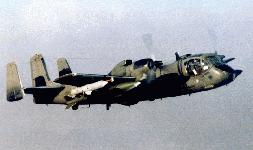 The aircraft flew seven days a week, night and day since 1964 to keep a constant vigil on
North Korean activities along the Demilitarized Zone. Missions were not canceled except during the very worst weather. When one aircraft returned to base another was already on guard along the DMZ. As soon as they landed, maintenance crews begin preparing them for the next flight.
The Mohawk provided early warning on enemy activity using a variety of imagery equipment such as still and infrared photography as well as side-looking airborne radar.
The aircraft flew seven days a week, night and day since 1964 to keep a constant vigil on
North Korean activities along the Demilitarized Zone. Missions were not canceled except during the very worst weather. When one aircraft returned to base another was already on guard along the DMZ. As soon as they landed, maintenance crews begin preparing them for the next flight.
The Mohawk provided early warning on enemy activity using a variety of imagery equipment such as still and infrared photography as well as side-looking airborne radar.
With the deployment of the Mohawk's replacement, the ARL (Airborne Reconnaissance Low), the OV-1D Mohawk was retired from the Army inventory by the 3rd MI Battalion, 501st MI Brigade, INSCOM, Camp Humphreys, Korea, Sept. 21, 1996.
Specifications | |
| Span | 42 ft 0 in (12.8 m) |
| Length | 41 ft 0 in (12.5 m) |
| Height | 12 ft 8 in (3.86 m) |
| Wing area | 330 sq. ft (30.65 m 2) |
| Weights |
10,370 LB (4,704 kg) Empty 13,040 LB (5,915 kg) Loaded (clean) 15,399 LB (6,985 kg) Loaded with two 150 US Gal (568 l) external tanks |
| Power Plant |
Two Lycoming T53-L-7 free-turbine turboprops each rated at 1,150 eshp (1,100 shp plus 124 lb/56.3 kg residual thrust). |
| Maximum speed | 308 mph (496 km/h) at 5,000 ft (1,520 m) |
| Maximum cruise | 297 mph (478 km/h) |
| Service ceiling | 30,000 ft (9,150 m) |
| range | 441 miles (710 km) at 230 mph (370 km/h) at 5,000 ft (1,520 m)(internal fuel) |
| Take-off | 950 ft (290 m) to clear 50 ft (15.2 m) |

